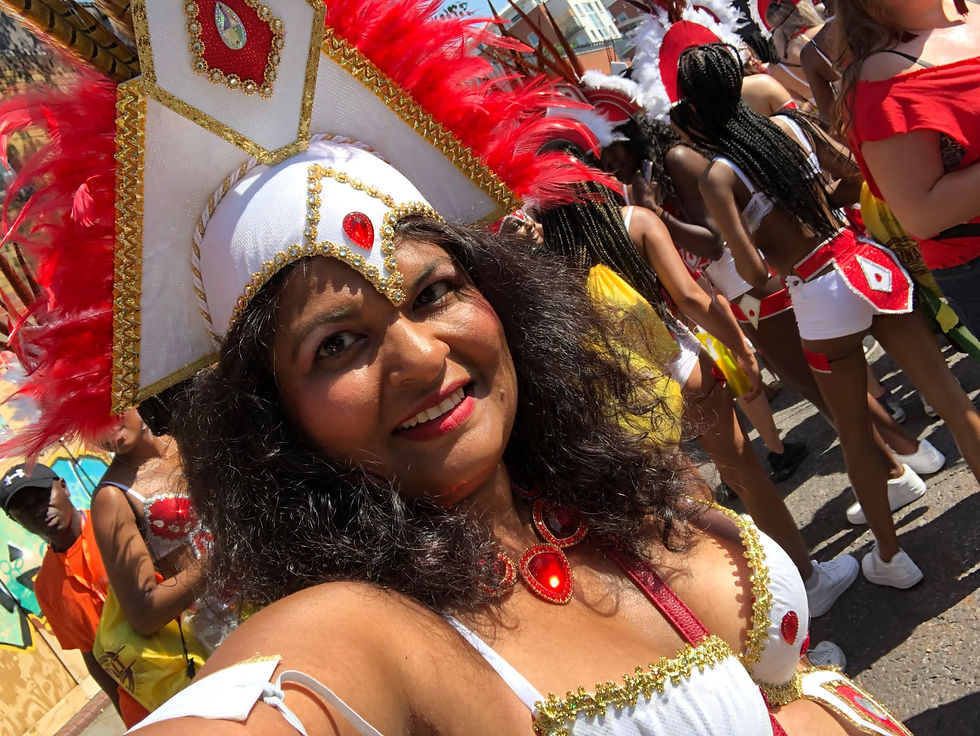Notting Hill Carnival – going back to the roots.
- anne

- Aug 28, 2021
- 4 min read
Updated: Aug 29, 2021
In London, August bank holiday (last Monday of the month) is synonymous with carnival – something that took me some time to get used to as in many places around the world carnival is in February – the weekend before lent, culminating with Mardi Gras – aka shrove or pancake Tuesday … but, I soon discovered that ‘Notting Hill’ is a different kind of carnival.
It’s not hard to trace the west london extravaganza back to Claudia Jones. What surprises me, however, is how few people have heard of her and the lack of recognition, considering her lifelong achievements – way beyond founding the carnival. But, I guess, not unexpected when you think about the number of Black feminist activists who have been erased from our history! Time to rebuild the narrative of our lost past and reinstate the sheroes that shape this city.
Revolutionary road

Claudia Jones (1915 – 1964), née Vera Cumberbatch, was born in Trinidad in 1915. When she was nine, her family moved to Harlem, New York, where her mum quite literally worked herself to death in a garment factory to support her family – like so many Black women workers. This and the incessant racism and discrimination politicised her. She joined the Communist Party and became a proficient writer, developing the foundations of an intersectional (before Kimberlé Crenshaw coined the word) theory framework on race, class, gender and anti-imperialism, using her position to advocate for poor Black women workers. Her ground-breaking ideas shaped the politics of second-wave feminists and influenced on thinkers like Angela Davis.
It wasn’t long before she attracted the attention of the authorities (surprise, surprise!). Arrested in 1948, she was deported to the UK during the punitive era of McCarthy’s witch-hunts that swept the US in the early 1950’s. In Jones’ own words: “I was deported from the USA because as a Negro woman Communist of West Indian descent, I was a thorn in their side in my opposition to Jim Crow racist discrimination against 16 million Negro Americans in the United States … I was deported because I urged the prosecution of lynchers rather than prosecution of Communists and other democratic Americans who oppose the lynchers and big financiers and warmongers, the real advocates of force and violence in the USA”.

She arrived in the UK in 1955 – a period of widespread racism, of calls for the control of Black immigration (some things haven’t change!) and when the British Union of Fascists openly paraded around Brixton! This made her political thinking and organising all the more important. In 1958, she founded the West Indian Gazette (The WIG) with Jamaican activist, Amy Ashwood Garvey. It had regular features by theoreticians such as Franz Fanon, Nelson Mandela and James Baldwin - connecting the daily struggles of Black immigrants in the U.K. to the ongoing struggle against racism, imperialism and colonialism globally.
Carnival as resistance

One of the key aspects of Jones thinking was around the idea of “taking space” as an integral part of Black working-class resistance. And the WIG did just that – it provided a space for Caribbean culture in London against the background of the Notting Hill Race Riots of 1958. It was also played a crucial role in community organising, including as the sponsor and fundraiser for London's first Caribbean Carnival, in 1959. The carnival emerged from the darkness of racism and violence like a lotus flower from a swamp, as a physical and spiritual representation of Black defiance. Jones’ vision was to bring together a community of West Indian people that would resist racist attacks and showcase their creative and artistic contribution to British culture – and 52 years on it still does.
“Spirit of a people that cannot be contained,
that which therefore contains the genesis of their own (self-articulated) freedom”
Claudia Jones
In the early years, the carnival was indoors – the first party took place in St Pancras Hall in King’s Cross. It only hit the streets of Notting Hill after Jones’ untimely death in 1964 – and became her lasting legacy. And here is an interesting twist to the story - Claudia Jones, Black feminist revolutionary, is buried to the left of Karl Marx in Highgate East cemetery.
Trinidad to London

I was curious to find out more about the carnival’s origins and was lucky spend time chatting to my friend Seema Rampersad, who, like Claudia Jones is from Trinidad and Tobago – the heart of the rich carnival tradition that is now also gracing the streets of London. Trinidadian festivities go back to the arrival of French settlers who celebrated alongside to free people of colour before lent with elaborate costumes and rich foods, and is inextricably linked to slavery. Slaves could not take part, instead, however, they celebrated during the sugar cane harvest and burning – hence the French ‘cannes brûlées’ – which became Canboulay and featured calypso music, which was used to mock plantation owners and slave masters, as well as being a form of secret communication between slaves. With time, calypso led to the emergence of soca music, now the main soundtrack of modern carnival. After the emancipation of slaves in 1838, Canboulay became even more important as a symbol of freedom and defiance that continues to this day, with women playing a important part.
Seema’s enthusiasm is palpable when she talks about the ‘playing carnival’. In Trinidad and Tobago, it is a huge celebration, with preparations taking months - from band rehearsals to costume making. The two-day festival begins with J’ouvert, day break on Monday – a very colourful and slightly messy affair – and moves into ‘playing Mas’. Floats of up to 3,000 people, bands, steel bands and sumptuous costumes that capture the spirit of carnival as it snakes through the streets to the raucous rhythm of drumbeats and dancers’ sexy moves. Seema tells me that while these can be misinterpreted as being too sexual or provocative, they need to be seen as a form of expression, freedom and body positivity.
After chatting to her, I felt a wave of nostalgia reminiscing about carnivals past - this is the second year running we're missing the electrifying atmosphere of the carnival ... but good news for me, Seema has invited me to ‘play carnival’ with her next year – can’t wait to shake those hips to the sound of drums and feel the vibe of Europe’s largest street festival. Better go and practice my moves and grooves! 🥳
Meanwhile, go check out Seema's excellent blog: Connecting the dots.














Comments